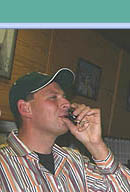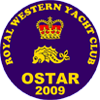The OSTAR, the Original Single Handed Transatlantic Race, is a sailing race open to yachts ranging in length from 30 to 50 feet and is held every 4 year since 1960. Start is in Plymouth, UK, and finish in Newport, Rhode Island, USA. The start will be at noon, May 25th 2009.
Former participant of this race, Jerry Freeman, has written a resume as to how one experiences this race:
The race divides conveniently into three fun size portions: The first thousand miles includes the sleepless zone getting clear of the English Channel, the Bishop Rock light is probably the last sight of land at the Isles of Scilly, then beating out to 11degrees west before dropping off Europe’s steep edge into ocean proper. These first few days are the hardest because sleep is at a premium, the proximity of hard Cornish granite and solid steel ships precludes any rest. The fishing industry has almost gone but it only takes one! Finding the sea legs after a week of carousing at the Royal Western Yacht Club is always a challenge while dehydration and lack of regular food conspire to bring even the most experienced sailors almost to their knees.
The middle thousand is the lonely stretch. Climbers will be familiar with the term 'exposure' to describe the long drop on a steep but easy pitch. The mid Atlantic is like that, the sailing is not technically difficult but it does feel pretty scary as the point of no return approaches. Unlike a mountain climb where the location and severity of difficult pitches are well understood, the sailor never knows where or when the test will be, he just knows a beating will come soon.
Fortunately as the fleet progress along 50-north latitude the ocean is warming up under the influence of the Gulf Stream diffusing eastward but the waves are enormous and gale frequency tops out 8% in June. Seven lows a month on average form off Newfoundland to track east or north east at 25 knots so the slower boats unfairly suffer more bad weather than the rocket ships. The wind changes constantly in force and direction demanding almost continuous sail area changes. The solo skipper, now fully acclimatised and in tune with his environment, enjoys a euphoria in ocean racing that can only be experienced by the chosen few. Perhaps akin to weightlessness in space this sensation is not available to those who always sail near land. The skipper and boat meld into a single entity, each knowing and recognising the others needs. Automatically and seamlessly day and night without hesitation the yacht is trimmed and steered with optimum efficiency like a silver dart unerring it its aim. Here the true enormity of the ocean and the utter insignificance of a man cannot be denied.
This elevated state of being is shattered as the ice reports come in; bergs and growlers down to 44 degrees north. The last thousand begins by threading the needle between the icebergs on the Grand Banks and the north wall of the Gulf Stream with its enticing warm blue counter current stealing 30 miles a day from the unwary. Continental America appears with a sudden bump in the fog at the tip of the Newfoundland Grand Banks; the echo sounder that was dormant for two weeks now shows 30 metres and that feels dangerously shallow after the 3000 metres over the graveyard of the Titanic.
Racing now in seas seldom sailed the astute navigator tries to stay in the chilly shelf seas for the final 800 miles, past Nova Scotia and Sable Island, to avoid the counter current. The cost on this route is the associated poor visibility and the risk of collision with the menacing Trawlers that figure high in OSTAR legends. Light head winds from the southwest and calms make this the slowest section of the race, although the improved radio reception from local FM stations is a benefit that many racers fail to fully appreciate at this time, Yee Haa!
The Georges Bank, Nantucket shoals, Martha’s Vineyard, Nomans Land: these names are as familiar to the Ostar skipper as they are to the New Englander, it just means that his race is coming to a close and in the next 36 hours he will have little sleep until Brenton Reef is on the chart and that slow winking red at Castle Hill comes abeam. Spare a thought for the unshaved and odiferous sailor when you see him blinking in the morning sunlight on Goat Island dock, he only wants a beer and a very long sleep and then he may tell you all about it.
More Americans have flown into space than have raced solo across the Atlantic, but there is no age limit for this voyage of discovery. Who will step up to the plate in 2009?
For the first time, all competitors will be equipped with a tracker. At frequent intervals, each yacht automatically sends out it's position which will be published on a web site. It can be reached through the official OSTAR2009 site by clicking the icon to the left of this page.


